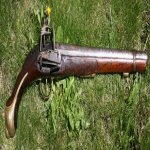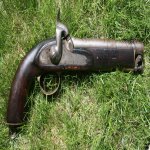- Location
- Somewhere under the rainbow
You are using an out of date browser. It may not display this or other websites correctly.
You should upgrade or use an alternative browser.
You should upgrade or use an alternative browser.
Antique Photos--Post what you got
- Thread starter peckerwood
- Start date
maltextract
Regular
- Location
- Rural Manitoba
That's a sweet rig there Carbinegirl!
- Location
- St. Paul AB
New Shiloh? What's your plan for it?
- Location
- Somewhere under the rainbow
That's a sweet rig there Carbinegirl!
Thanks. I really enjoy it
- Location
- Somewhere under the rainbow
New Shiloh? What's your plan for it?
Yeah. I love Shiloh. They make a great gun. Long range target. New to it, so building up skill and knowledge.
Willy Tincup
CGN frequent flyer
- Location
- Owen Sound
Its a Ballard carbine.
Its a Ballard carbine.
Thanks.
Its a Ballard carbine.
Any idea on value?
Londonshooter
CGN frequent flyer
- Location
- SW Ontario
Sure looks like a match to this Ballard's patent carbine:
https://auctions.bidsquare.com/view-auctions/catalog/id/767/lot/272140
https://auctions.bidsquare.com/view-auctions/catalog/id/767/lot/272140
looks nice, have you fired it?
Note the Samurai sword!
View attachment 176950
View attachment 176950
looks nice, have you fired it?
Not yet ☺
I also posted this picture in the Hunting and Sporting Shotguns picture thread, because a gun can be a usable hunting gun AND an antique, age-wise!
Here is a Charles William Lancaster 12-gauge under-lever centre-fire gun, possibly built as a base-fire, with the conical base-fire strikers replaced by normal centre-fire ones. Or it was built as-is to use the early Pottet/Boxer or Schneider/Daw centre-fire cartridges. The Lancaster order book simply records it as a '12-bore under-lever centre-fire', as Lancaster didn't distinguish between the two systems in his records. It is usable without too much bother, as the damascus barrels were nitro-proofed for 1 1/8 oz loads at some point in the recent past. It has 2 1/2" chambers and as it was built before the days of choke, it is cylinder bore.
This particular gun was built in 1864 for Colonel Sir Thales Pease KCB, and would have sold for 65 guineas, as Lancaster was the highest-priced of the top London makers. The action is Lancaster’s 'slide-and-tilt' type, where the underlever moves the barrels forward before they can swing on the hinge. The action face is not at the normal 90 degree angle to the flats, instead it is at an acute angle, making for a very strong closure (undoubtedly it must have been difficult to make, with the hand tools of the day - only Lancaster made these). It has simple extractors, which hide their importance - this was the first British game gun to have an extractor, an important first step towards the later ejectors. Using nose-less hammers was a design flourish that Lancaster favoured, and the locks are non-rebounding.
As to the action design, there is much history there. Albert Henry Marie Renette of Paris obtained two French patents for exterior-primed (capping breechloader) guns with slide-and-tilt actions in 1820, or seven years before Casimir Lefaucheux patented his hinge-action capping breechloading gun in 1827, the first step towards his pinfire invention of 1834. In 1853 Renette's son in law and partner, Louis Julien Gastinne, obtained French patent No. 9058 for this slide-and-tilt breech action on a hammer gun, intended to use the new internally-primed centerfire cartridges (another French invention). The prolific British patent agent Auguste Edouard Loradoux Bellford patented the design in Great Britain, patent No. 2778 of 1853. This is the patent that was later assigned to Charles Lancaster and used as the design for his base-fire cartridge, and the story behind ‘Charles Lancaster’s Patent’ being marked on his guns – though the patent was never taken out in his name.
The end result is a beautifully balanced gun, and with Ruffed grouse season now open, Sir Pease’s Lancaster is going back into the field, 154 years after leaving Lancaster's 151 New Bond Street London shop.

Here is a Charles William Lancaster 12-gauge under-lever centre-fire gun, possibly built as a base-fire, with the conical base-fire strikers replaced by normal centre-fire ones. Or it was built as-is to use the early Pottet/Boxer or Schneider/Daw centre-fire cartridges. The Lancaster order book simply records it as a '12-bore under-lever centre-fire', as Lancaster didn't distinguish between the two systems in his records. It is usable without too much bother, as the damascus barrels were nitro-proofed for 1 1/8 oz loads at some point in the recent past. It has 2 1/2" chambers and as it was built before the days of choke, it is cylinder bore.
This particular gun was built in 1864 for Colonel Sir Thales Pease KCB, and would have sold for 65 guineas, as Lancaster was the highest-priced of the top London makers. The action is Lancaster’s 'slide-and-tilt' type, where the underlever moves the barrels forward before they can swing on the hinge. The action face is not at the normal 90 degree angle to the flats, instead it is at an acute angle, making for a very strong closure (undoubtedly it must have been difficult to make, with the hand tools of the day - only Lancaster made these). It has simple extractors, which hide their importance - this was the first British game gun to have an extractor, an important first step towards the later ejectors. Using nose-less hammers was a design flourish that Lancaster favoured, and the locks are non-rebounding.
As to the action design, there is much history there. Albert Henry Marie Renette of Paris obtained two French patents for exterior-primed (capping breechloader) guns with slide-and-tilt actions in 1820, or seven years before Casimir Lefaucheux patented his hinge-action capping breechloading gun in 1827, the first step towards his pinfire invention of 1834. In 1853 Renette's son in law and partner, Louis Julien Gastinne, obtained French patent No. 9058 for this slide-and-tilt breech action on a hammer gun, intended to use the new internally-primed centerfire cartridges (another French invention). The prolific British patent agent Auguste Edouard Loradoux Bellford patented the design in Great Britain, patent No. 2778 of 1853. This is the patent that was later assigned to Charles Lancaster and used as the design for his base-fire cartridge, and the story behind ‘Charles Lancaster’s Patent’ being marked on his guns – though the patent was never taken out in his name.
The end result is a beautifully balanced gun, and with Ruffed grouse season now open, Sir Pease’s Lancaster is going back into the field, 154 years after leaving Lancaster's 151 New Bond Street London shop.

Londonshooter
CGN frequent flyer
- Location
- SW Ontario
Steve thanks for posting this beauty. Centerfire.
Steve thanks for posting this beauty. Centerfire.
Hey there, Londonshooter! I considered myself lucky to have a 14-gauge example of this gun, made in 1858. Beautiful, but sadly unusable. I was surprised, to say the least, to come across a nitro-proofed 12-bore example. Life has its surprises, and sometimes they are good ones.














































































